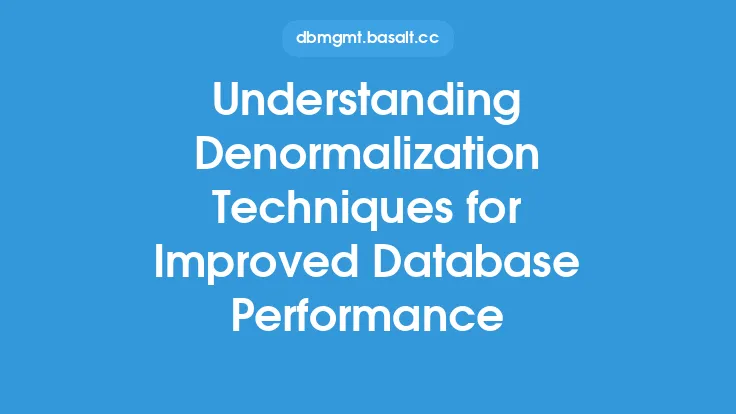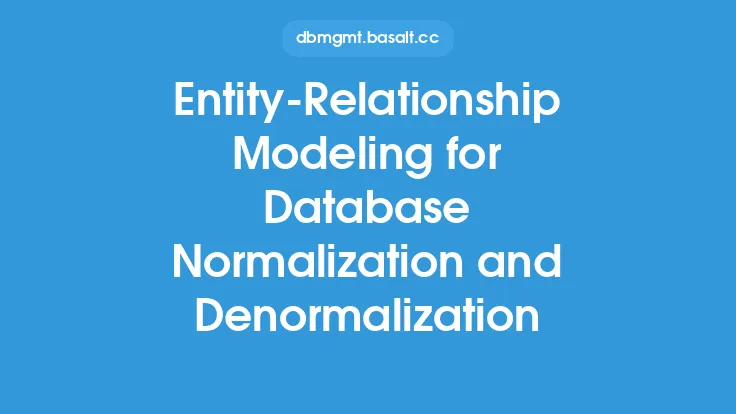Database design is a crucial aspect of any application or system that relies on data storage and retrieval. One of the key concepts in database design is normalization, which refers to the process of organizing data in a database to minimize data redundancy and improve data integrity. In this article, we will delve into the world of database normalization and denormalization techniques, exploring the principles, benefits, and trade-offs of each approach.
Introduction to Database Normalization
Database normalization is a technique used to design a database schema that is scalable, maintainable, and efficient. The goal of normalization is to eliminate data redundancy and dependency, which can lead to data inconsistencies and anomalies. Normalization involves dividing large tables into smaller, more manageable tables, and defining relationships between them. This process helps to reduce data duplication, improve data integrity, and make it easier to maintain and update the database.
Normalization Rules and Techniques
There are several normalization rules and techniques that are used to design a normalized database schema. The most common normalization rules are:
- First Normal Form (1NF): Each table cell must contain a single value, and each column must contain only atomic values.
- Second Normal Form (2NF): Each non-key attribute in a table must depend on the entire primary key, not just one part of it.
- Third Normal Form (3NF): If a table is in 2NF, and a non-key attribute depends on another non-key attribute, then it should be moved to a separate table.
- Boyce-Codd Normal Form (BCNF): A table is in BCNF if and only if it is in 3NF, and there are no transitive dependencies.
- Higher Normal Forms: There are additional normalization rules, such as 4NF, 5NF, and 6NF, which deal with more complex relationships and dependencies.
Benefits of Database Normalization
Database normalization offers several benefits, including:
- Improved data integrity: Normalization helps to eliminate data redundancy and dependency, which can lead to data inconsistencies and anomalies.
- Reduced data duplication: Normalization reduces data duplication, which can lead to storage savings and improved data retrieval performance.
- Improved scalability: Normalization makes it easier to add new data or modify existing data, without affecting the entire database.
- Improved maintainability: Normalization makes it easier to maintain and update the database, as changes can be made to individual tables without affecting the entire database.
Introduction to Database Denormalization
Database denormalization is a technique used to intentionally deviate from the principles of normalization, in order to improve performance or reduce complexity. Denormalization involves combining data from multiple tables into a single table, or duplicating data to reduce the number of joins required. Denormalization can be used to improve query performance, reduce the complexity of queries, or improve data retrieval performance.
Denormalization Techniques
There are several denormalization techniques that can be used, including:
- Data duplication: Duplicating data from one table to another, to reduce the number of joins required.
- Data aggregation: Combining data from multiple tables into a single table, to reduce the number of joins required.
- Pre-computation: Pre-computing and storing data that is frequently used, to reduce the number of calculations required.
- Materialized views: Creating a physical table that contains the result of a query, to reduce the number of queries required.
Trade-Offs of Denormalization
While denormalization can offer several benefits, it also has some trade-offs, including:
- Data inconsistency: Denormalization can lead to data inconsistencies, as data is duplicated or aggregated.
- Data redundancy: Denormalization can lead to data redundancy, as data is duplicated or aggregated.
- Increased storage requirements: Denormalization can lead to increased storage requirements, as data is duplicated or aggregated.
- Reduced data integrity: Denormalization can lead to reduced data integrity, as data is duplicated or aggregated.
Choosing Between Normalization and Denormalization
The choice between normalization and denormalization depends on the specific requirements of the application or system. Normalization is typically used in applications where data integrity and consistency are critical, such as in financial or e-commerce applications. Denormalization is typically used in applications where performance is critical, such as in real-time analytics or gaming applications. Ultimately, the choice between normalization and denormalization depends on the specific trade-offs and requirements of the application or system.
Best Practices for Normalization and Denormalization
There are several best practices that can be followed when implementing normalization and denormalization techniques, including:
- Understand the requirements of the application or system: Before implementing normalization or denormalization techniques, it is essential to understand the requirements of the application or system.
- Use normalization as the default approach: Normalization should be used as the default approach, unless there is a specific reason to use denormalization.
- Use denormalization judiciously: Denormalization should be used judiciously, and only when there is a specific reason to do so.
- Monitor and adjust: The database schema should be monitored and adjusted as necessary, to ensure that it is meeting the requirements of the application or system.
Conclusion
In conclusion, database normalization and denormalization are two techniques that are used to design a database schema that is scalable, maintainable, and efficient. Normalization is a technique used to eliminate data redundancy and dependency, while denormalization is a technique used to intentionally deviate from the principles of normalization, in order to improve performance or reduce complexity. The choice between normalization and denormalization depends on the specific requirements of the application or system, and ultimately, the choice depends on the specific trade-offs and requirements of the application or system. By following best practices and understanding the requirements of the application or system, developers can design a database schema that meets the needs of the application or system, and ensures data integrity, consistency, and performance.





